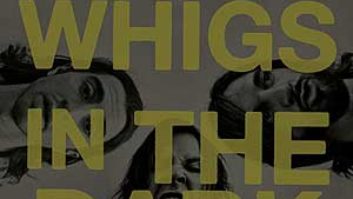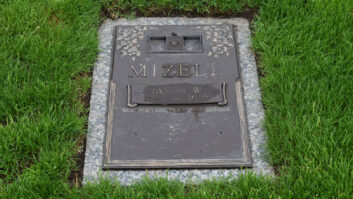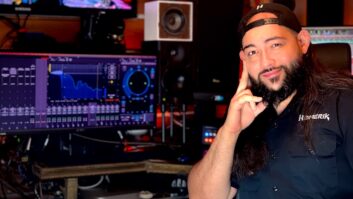Jay Joyce in his spacious control room
Photos: Giles Reaves
Producer/engineer/songwriter Jay Joyce used to have a home in West Nashville — until his studio, Tragedy/Tragedy, took it over. What started as a small pre-production space nearly 15 years ago has grown into a full-blown tracking and mix room that occupies the entire first floor of his two-story abode.
During the studio’s gradual evolution (more tracks added, speakers swapped, equipment upgraded), Joyce produced, engineered and/or played some of his finest-sounding work, including portions of Patty Griffin’s Flaming Red and Tim Finn’s Say It Is So, on up through work for Atticus Fault, Rubyhorse, Plumb, Abra Moore and, most recently, Audio Adrenaline, Eric Church, Alternate Roots and the Derek Trucks Band.
His current setup centers around a Sony DMX-R100 24-bit/96k digital console paired with a Pro Tools×HD workstation. Outboard gear includes multiple Teletronix LA-2As, Universal Audio 1176s, Empirical Labs Distressors, Telefunken V76s and an Altec 1567 with API op amps.
To accommodate the large, open studio area, Joyce installed JBL LSR 6328 monitors in his 26×20 control room to go along with his four NHT subs and a pair of NS-10 near-fields. Tuned by studio designer Carl Tatz, the recording area has only one iso booth — a 20×16 drum room — while a WhisperRoom in the garage holds the guitar amps. Musicians play together in the room without headphones, with baffles used to divide the space, if needed. “Everybody’s sitting next to each other, talking to each other, nobody’s on a talkback mic, and the only person in another area is the drummer and we can see him through the glass doors,” says Joyce. “The studio’s really conducive to live band recording.”
The drum room
Joyce works faster this way, which allowed him to produce seven albums in one year, on top of work as a remixer, songwriter, and studio and live musician. “I like to work fast,” he says of his production style. “When you’re moving quickly, there’s not a lot of thought. Everybody kind of goes with their gut, which always seems to be the thing that you try to get back to anyway.”
A monster guitar player, Joyce fronted his own hard rock band, Iodine, in the early to mid-’90s. When the band split, he became an in-demand sideman, playing on albums from The Wallflowers, Iggy Pop, October Project, K.T. Oslin, Gillian Welch, Radney Foster, and locals such as Daniel Tashian, Bob Bradley and Matthew Ryan, among others. His work in the studio soon migrated into the control room, where he’s assembled a diverse discography as a producer and recording and mix engineer.
For one of his recent projects, the forthcoming Songlines album from the Derek Trucks Band, Joyce recorded in his typical “speed demon” style, and ended up both recording and mixing the project at his studio. “When we first started, we talked about doing the album in a commercial studio because it’s a pretty big band,” says Joyce. “But Derek and Mike [Mattison], the singer, came over here to write a little bit before we started recording. And they really liked the place, so we wound up just doing it all here.”
The drummer and percussionist were the only musicians isolated during the tracking sessions. Everyone else played together in the main room. “We just went for it live,” he says. “There are minimal overdubs, no click track; just a real band playing live music. Even some of the vocals were live. And we did it in a fairly short amount of time, like two weeks.”
The band held on to this “go with your gut” philosophy up through the mixing process. “We took it one song a day,” Joyce recalls. “We’d finish the track and then they’d leave. I’d do a few tweaks and when everybody came in the morning, we’d finish the mix and move on. I didn’t really expect them to be the mixes, but at the end, everybody agreed that those were the mixes.”
Joyce has gradually expanded and upgraded his studio to the point where “Starbucks is really the only reason to leave the house,” yet he knows that the human element is what makes the recording great. “Some of the best records I’ve recorded were on a [Roland] 1680,” he says. “And some of the worst records I’ve recorded were on a Neve console and a tape machine. As long as the music’s good and the spirit is there, it doesn’t matter what you’re recording on.”







